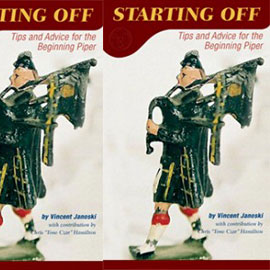Be A Stronger Bagpiper II: STAYING IN TUNE
Being an active bagpiper takes considerable dedication. The hours of practice and the rigor of travel and competition/performance can take their toll on you physically. A bagpiper may develop a laundry list of physical conditions that are directly related to the hours of practice time put in. Numbness in the hands or arm, aches in the shoulder or back, soreness in the neck or arms, all of these are preventable with the right kind of “tuning.”

Strengthen key muscles for good bagpiping!
Serious athletes all have a routine of stretches and exercises that help them avoid injury. Why would serious pipers be any different? The steps you take now will help you avoid difficulty later.
Deeper down in Daniel Duane’s Men’s Journal article “Everything You Know About Fitness Is a Lie,” espoused in a previous post, is a handy bit about his conversation with the late Kevin Brown, trainer of Olympic athletes:
“Every big joint in your body, Brown explained, has what are called prime movers, meaning big muscles that govern the main action, like the biceps and triceps. But every joint also has a bunch of little stabilizer muscles. Sedentary lives, camped out in office chairs, allow those stabilizers to atrophy, raising two problems: First, if you have powerful prime movers from doing muscle-isolation machines at the gym but weak stabilizers because you rarely get to play a sport, you can’t access all your strength when you, say, bang off a mogul on a ski hill. “It’s like trying to fire a cannon from a canoe,†Brown told me. The prime movers fire big, but the strength dissipates en route to the core. Second, and worse still, the strength of the prime movers can shred your unstable joints.”
Brown’s point is that it is these stabilizer muscles that form the foundation of strength. Never mind sports, strain on these muscles can make playing bagpipes a chore. Anyone who has tried to play bagpipes with a rotator cuff problem or back troubles knows what I’m talking about. The good news is that these muscles can be “tuned” and strengthened to help them work better for you. It is an often overlooked aspect of the bagpipe that playing pipes is a near athletic endeavor. The number of muscle groups engaged in a single standing performance on the band pitch rivals anything done in any athletic pursuit let alone other musical efforts.
It is easy to ignore but, we as players also need to think of our physical strength the same way we think of our finger technique. That physical strength needs to be built with exercising the same way your bagpipe embellishments do. Kevin Brown’s simple exercises to build those stabilizers and avoid injury are shown in the graphic above. They would work just as well to build the right things for bagpipe strength. Well, maybe not the knees so much, but certainly strong shoulders and back would go a long way toward increasing your ability to stand and play a good solid pipe for extended periods. These are simple physical exercises that can be easily worked into the busiest of pipers’ lives.
So now you’re becoming stronger. What other steps can you take to stay in “tune?”
Take frequent breaks. Make sure you not only stretch and limber up before practice but, also take breaks to stretch during your practice. Constant tension and repetitive stress are the prime conditions for trouble. The body builds up metabolic waste over time and constant stress on the joints and muscles during a marathon bagpipe session will only bring afflictions down the road. Long playing sessions can easily have a negative impact on your performance.
Pay attention to ergonomics. Take note of how you stand and be aware of your body position while you play your instrument. Pain is your body’s signal that something is amiss. Pay attention to what is troubling you and diagnose your posture and playing position to make corrections and relive the stress you’re placing on muscles and joints. Your posture is likely the biggest factor in any discomfort you might be experiencing. Make sure your stance is erect and balanced with your bagpipe on your shoulder and your weight is distributed evenly on your legs. You’ll experience all sorts of physical ailments if you’re always twisted in some strange way and you are using your strength to hold up yourself and your bagpipe.
 Pipehacker
Pipehacker







